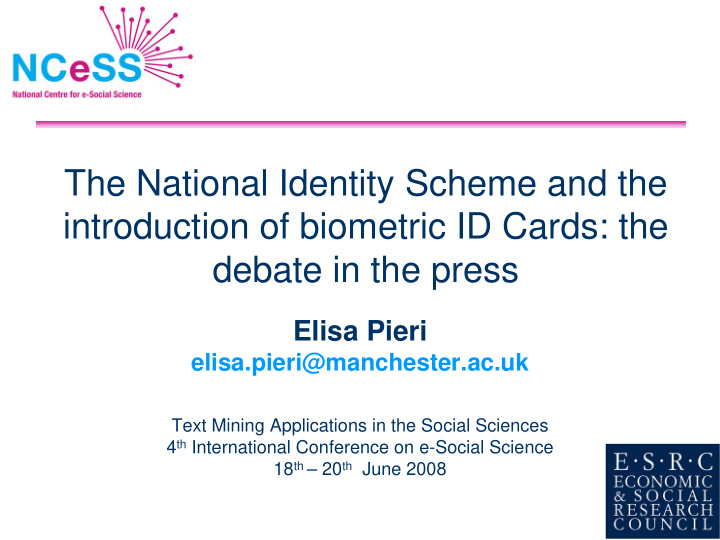



The National Identity Scheme and the introduction of biometric ID Cards: the debate in the press Elisa Pieri elisa.pieri@manchester.ac.uk Text Mining Applications in the Social Sciences 4 th International Conference on e-Social Science 18 th – 20 th June 2008
E PIERI – NIS and the introduction of biometric ID Cards – 4 th Int. Conf. of e-Social Science, 18-20 June08 BACKGROUND TO THE STUDY (1) The social science research on IDs and the National Identity Scheme takes place as part of a TEXT MINING FOR FRAME ANALYSIS PROJECT (TMFA) The Research Team: Prof Peter Halfpenny & Prof Rob Procter, Dr Yuwei Lin, Elisa Pieri and June Finch, NCeSS Dr Sophia Ananiadou and Davy Weissenbachers , NaCTeM Dr Farida Vis, CRESC Prof Peter Golding and Dr Thomas Koenig, Loughborough University
E PIERI – NIS and the introduction of biometric ID Cards – 4 th Int. Conf. of e-Social Science, 18-20 June08 BACKGROUND TO THE STUDY (2) FA: how texts are framed to shape the perceptions/ opinions to prioritise certain interventions. TM: processing large amounts of textual data Although computer-assisted qualitative data analysis packages are available to manage and manipulate textual and/or multimedia data, this project aims to explore the usefulness of text-mining techniques for the analysis of large media corpora. It builds on the Automatic Summarisation for Systematic Reviews using Text Mining (ASSERT) project. The project (Feb 08- July 09/Nov 09) is funded by JISC.
E PIERI – NIS and the introduction of biometric ID Cards – 4 th Int. Conf. of e-Social Science, 18-20 June08 THE DEBATE (1) Nat Identity Scheme The controversy in parliament 2006 Legislation Delievery Plan 2008 Heavy biometric component Aim: investigate debate on national newspapers explore the arguments mobilised to support/oppose the introduction of the scheme/ID cards carry out media content analysis using Frame Analysis (FA) as the main methodology (aided by Atlas.ti software) FA as multi-method approach ‘frames’ not only as cognitive schemata (perceive, organise and communicate experience), but also as devices used strategically (to cast ‘events’ in a certain light, define ‘the issues’ that we ought to attend to, prioritise some intervention over others)
E PIERI – NIS and the introduction of biometric ID Cards – 4 th Int. Conf. of e-Social Science, 18-20 June08 THE DEBATE (2) � Importance of Identity management and assurance (private & public) � Financial and banking sectors took the lead – remote transactions, digitalisation of purchases, mobility of businesses � Citizen mobility (border controls) � Climate of heightened security (new ways of capturing and managing passengers’ and citizens’ identities) � Digital trail (how we travel, what food we buy, how we use our mobile, how we access public/private services); from trail to profiling � Blurring the difference between identity assurance and profiling => many social, ethical, legal and political issues arise..
E PIERI – NIS and the introduction of biometric ID Cards – 4 th Int. Conf. of e-Social Science, 18-20 June08 THE DEBATE (3) � as covered on the UK national newspapers � Broadsheets (and their Sunday editions): The Daily Telegraph, The Telegraph on Sunday, The Guardian, The Observer, The independent, The Independent on Sunday, The Times, The Sunday Times � Tabloids (and their Sunday editions): The Daily Mail, The Mail on Sunday, The Mirror, The Sunday Mirror, The Sun � For a four months period: FEB - MAY 08 (launch of the Delivery Plan 2008) � Using LexisNexis (for academic purposes)
E PIERI – NIS and the introduction of biometric ID Cards – 4 th Int. Conf. of e-Social Science, 18-20 June08 SUMMING UP � Background of the study within the TMFA, its aims and those of the larger TMFA project � Context of the NIS and ID cards debate � Data collected for FA analysis � Testing whether text mining tools may aid the process
elisa.pieri@manchester.ac.uk THANK YOU
Recommend
More recommend